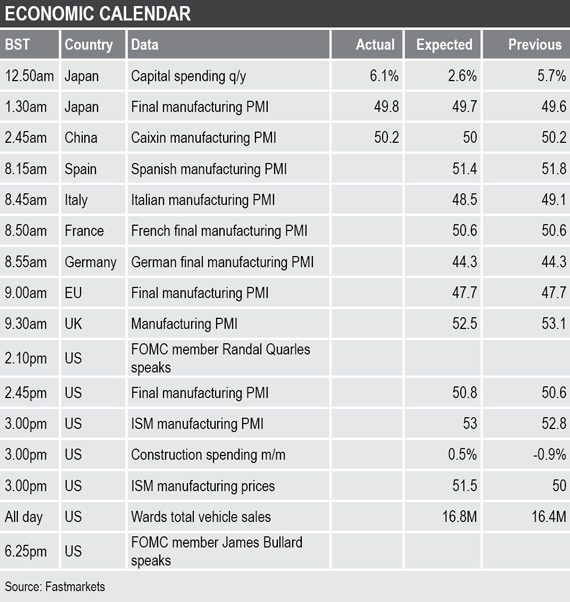- Trade war rhetoric escalates with Mexico now in focus
- Equites continue to show weakness while haven assets shine
- China’s Caixin manufacturing PMI holds steady; more PMI data out across Europe, US later
Base metals
Three-month base metals prices on the London Metal Exchange were for the most part flat to slightly firmer on the morning of Monday June 3. The exceptions were copper that was up by 0.3% at $5,843 per tonne and nickel that was off by 0.3% at $11,960 per tonne.
Tin and copper prices are extending multi-month lows, while the other base metals are trading sideways in low ground and therefore remain vulnerable.
In China, base metals prices on the Shanghai Futures Exchange were for the most part negative on Monday, with the most-active contracts down by an average of 0.5%, led by the July nickel contract that was down by 1.5%, while the September tin contract was unchanged. July copper was down by 0.4% to 46,170 yuan ($6,685) per tonne – the lowest the most-active contract has been for two years.
Spot copper prices in Changjiang were down by 0.7% at 46,040-46,150 yuan per tonne and the LME/Shanghai copper arbitrage ratio was at 7.90.
Precious metals
We wondered in recent Morning View reports whether gold had some catching up to do on the upside given the haven buying seen in government bonds and it has now done that with prices ramping higher since Thursday. Prices have so far reached a high of $1,312.95 per oz, the highest they have been since late-March. Silver has followed to a lesser extent and while the platinum group metals initially followed, they have failed to hold on to gains.
On the SHFE, the December gold contract is up by 1.6% compared with Friday’s close, while December silver is up by 1%.
Wider markets
Concerns about the slowdown in global economic activity has led to a collapse in oil prices with the spot Brent crude oil price down at $61.22 per barrel – a week ago, on May 27, it was quoted at around $70 per barrel.
The yield on benchmark US 10-year Treasuries has fallen further and was recently quoted at 2.1284% compared with 2.2699% at a similar time on Thursday. The yields on the US two-year and five-year treasuries have returned to a contango but are now below the 2% level at 1.9018% and 1.9047% respectively.
The German 10-year bund yield fell further into negative territory and was recently quoted at -0.2000%.
Asian equity markets were for the most part weaker this morning: Nikkei (-0.92%), Hang Seng (-0.12%), CSI 300 (-0.04%) and the ASX 200 (-1.19%), while the exception was the Kospi that was up 1.28%.
This follows weakness in western markets on Friday. In the United States, the Dow Jones Industrial Average closed down by 1.41% at 24,815.04, while in Europe, the Euro Stoxx 50 was down by 1.14% at 3,280.43.
Currencies
The dollar index remains choppy; it was recently quoted at 97.77, following Thursday’s high at 98.29, which failed to overcome the May 23 peak at 98.38.
With the dollar turning lower, the other major currencies are firmer; the euro (1.1166), sterling (1.2640) and the Australian dollar (0.6943), with the Japanese yen (108.31) showing extra strength while it soaks up haven buying too.
The yuan has flattened out in low ground and was recently quoted at 6.9070, compared with around 6.7100 in mid-April before the escalation in the US-China trade dispute.
Key data
Economic releases on Monday are focused on manufacturing PMI data that is out in Japan, China, Europe and the US. Japan’s manufacturing PMI picked up to 49.8 from 49.6, China’s Caixin manufacturing PMI held steady at 50.2 and Japan’s capital spending climbed 6.1%, after a 5.9% rise previously. So far this morning the data has surprised on the upside, if that trend were to continue then the markets could see a relief rally, but given the economic headwinds that may be asking a lot.
Other data due for release includes US construction spending and US total vehicle sales.
In addition, US Federal Open Market Committee members Randal Quarles and James Bullard are speaking.
Today’s key themes and views
The downward trends in the metals prices are dominating and with the US still pressing its trade agenda concerns are growing about a broad-based economic recession, which for the metals could further alleviate the tight fundamentals that most of the metals face. While the outlook is gloomy for now, it could change quickly if trade deals are made, but for now, hopes of that are fading. Until a US-China trade deal starts to look imminent again, the metals are expected to find levels to build bases.
The run-up in gold prices and sell-off in oil prices, highlight the increased concern that has built up in recent days and as concerns look set to deepen, gold’s rally looks set to run further.



